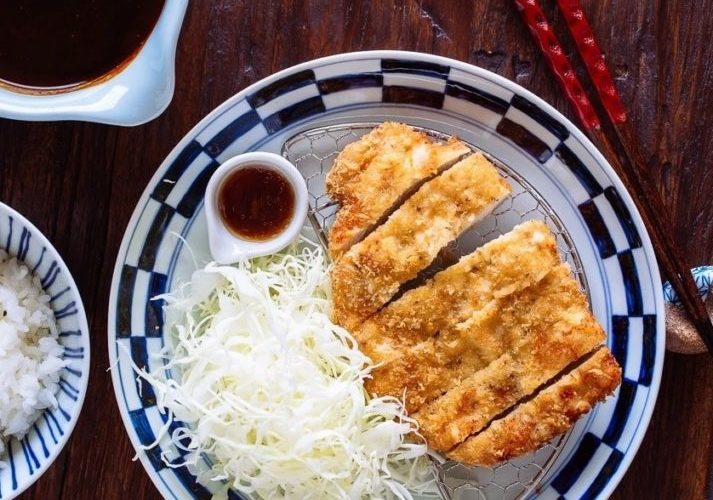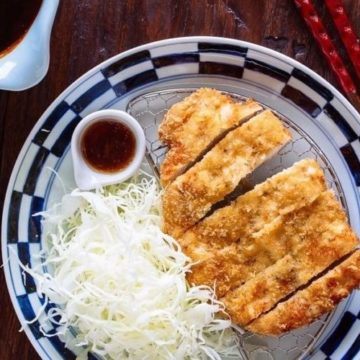Miso Katsu
If you thought the tangy and sweet tonkatsu sauce was the only sauce to enjoy Tonkatsu with, then today’s recipe might be a new discovery for you.
In Nagoya, people enjoy eating Tonkatsu with a miso-base sauce which is made of a dark red miso paste called Hacho Miso (八丁味噌). This miso is not your ordinary red, white or awase miso (mix of red and white).
For someone like myself who grew up eating Tonkatsu only with tonkatsu sauce, it was definitely a unique experience and the miso sauce is definitely an acquired taste.
It took me a while to build up my tastebuds to appreciate this new flavor. And guess what, now Mr. JOC and I both love Miso Katsu now and we’re quite excited to introduce this dish to you!
Ingredients
Katsu
- ½ cabbage to serve with Miso Katsu
- 4 pieces boneless pork loin chops ½ inch thick (4 pieces = 1 lb = 450 g)
- kosher/sea salt I use Diamond Crystal; Use half for table salt
- freshly ground black pepper
- ¼ cup all-purpose flour plain flour (1/4 cup = 4 Tbsp)
- 1 large egg 50 g w/o shell
- 1 Tbsp water
- 1 cup panko Japanese breadcrumbs (1 cup = 60 g)
- 4 cups neutral-flavored oil vegetable, canola, etc (or canola or any neutral flavor oil) (for deep frying)
Miso Sauce
- 1 Tbsp mirin
- 2 Tbsp sake
- ½ cup dashi Japanese soup stock; click to learn more (1/2 cup = 120 ml)
- 2 Tbsp sugar
- ¼ cup Hatcho Miso 1/4 cup = 4 Tbsp = 50 g
Instructions
- Gather all the ingredients.
- Cut or shred the cabbage into thin slices. Wash under cold running water and drain completely. Keep it cool in the fridge.
- Lower the heat and add 2 Tbsp. sugar, ½ cup (120 ml) dashi, and ¼ cup (4 Tbsp., 50 g) Hatcho Miso.
- To make Tonkatsu, remove extra fat from pork loin and make a couple of slits on the connective tissue between the meat and fat. The reason why you do this is that red meat and fat have different elasticity, and when they are cooked they will shrink and expand at different rates. This will allow the meat to stay nice and flat when deep frying and prevent from curling up.
- Pound the meat with a meat pounder, or if you don’t have one then just use the back of the knife to pound. Mold the extended meat back into original shape with your hands.
- Season both sides of the meat with salt and pepper.
- In a large bowl, whisk together 1 large egg and 1 Tbsp. water.
- Dredge in flour and remove excess flour.
- Heat oil in a pot over medium-high heat and wait till oil gets 350F (180C). If you don’t have a thermometer, stick a chopstick in the oil and see if tiny bubbles start to appear around the tip of the chopstick. Alternatively, you can drop one piece of panko into the oil, and if it sinks down to the middle of the oil and comes right up, then that’s around 350F (180C) as well. When the oil reaches that temperature, gently submerge the pork loin into the oil. Keep watching the oil’s temperature and make sure it doesn’t go over 350F (180C) or the pork katsu will look burnt.
- Deep fry for 1 minute on one side and flip to cook the other side for 1 minute. If your meat is thinner than ¾ inch, then reduce to 45 seconds for each side.
- Now take out the meat and remove the excess oil by holding it in a vertical position for a few seconds. Place on top of the wire rack (if wire rack is not available, use paper towel) and let it sit for 4 minutes. The hot oil on the exterior is slowly cooking the meat as it sits. Please do not cut to check whether the inside is cooked or not. We need to keep the panko shell on to retain the heat. While waiting, you can scoop up fried crumbs in the oil with a fine-mesh strainer.
- After resting for 4 minutes, bring the oil back to 350F (180C) of oil again and deep fry the meat for 1 minute (about 30 seconds each side).
- Remove from the oil and poke the meat with a chopstick and if clear liquid comes out then it’s done. Drain the oil by holding the meat vertically again for a few seconds. Then leave it on top of the rack or paper towel for 2 minutes. If you have to use the paper towel, try to keep the meat in a vertical position so it does not get soggy on one side.
Video
Notes
Recipe by Namiko Chen of Just One Cookbook. https://www.justonecookbook.com/nagoya-miso-katsu/
Tried this recipe?Let us know how it was!


